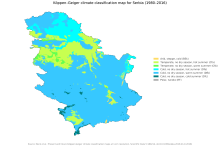Climate of Serbia
South and South-east of Serbia is subject to strong Mediterranean influences (hotter summers and milder winters).
However, the Dinaric Alps and other mountain ranges contribute to the cooling down a large part of the warm air masses.
[2] One of the climatic features of Serbia is Košava, a cold and very squally southeastern wind which starts in the Carpathian Mountains and follows the Danube northwest through the Iron Gate where it gains a jet effect and continues to Belgrade and can spread as far south as Niš.
[7] Serbia is one of few European countries with a very high risk exposure to natural hazards (earthquakes, storms, floods and droughts).
[10] The lowest recorded temperature in Serbia was −39.5 °C (−39.1 °F) (January 26, 2006, Karajukića Bunari in Pešter), and the highest was 44.9 °C or 112.8 °F (July 24, 2007, Smederevska Palanka).
